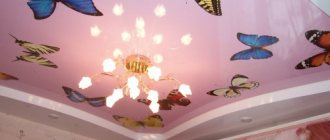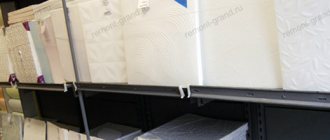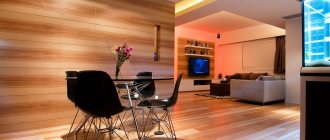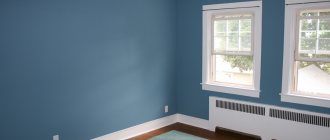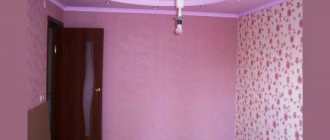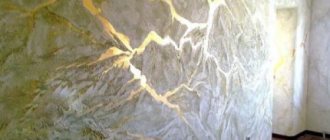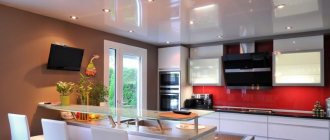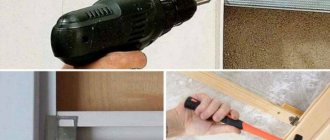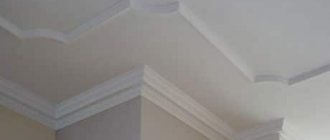What criteria should you use to choose paint?
First of all, you should determine the following points for yourself:
- how much money are you willing to pay for paint;
- whether it will be necessary to do wet cleaning of the ceiling in the future, and also in what room it will be located - dry or wet;
- whether it is necessary to eliminate defects on the surface for painting or whether it is sufficiently smooth;
- design approach (whether visual expansion of space is required using a certain color or surface texture);
- whether the room has certain negative factors for the ceiling (for example, if it is a kitchen).
If you analyze these parameters, it will be easier for you to decide on a specific option among the many paints offered.
Water-based ceiling paint comes in the following types:
- matte;
- glossy;
- semi-gloss;
- textured.
Based on their properties, paints are divided into waterproof and regular. The former can be used in bathrooms and kitchens, since the bathroom is characterized by its constant excessive humidity, and the kitchen needs frequent wet cleaning of the ceiling, because soot and droplets of fat quickly accumulate on its surface.
Useful tips
During the renovation process, all sorts of questions arise in our heads all the time. We will try to answer some of them.
Which water-based paint is best for the ceiling?
There are quite a few brands of water-based emulsion; these are: Sniezka, Feidal, Eskaro Relief, Eskaro Titan Lux 7. They all have common characteristics. The best are Feidal and Eskaro Titan Lux 7.
- The Feidal Antischimmel Weiss brand is designed specifically for rooms where there is a very high degree of humidity. It is successfully used to paint walls and ceilings in bakeries, breweries, kitchens, laundries and meat shops. Its consumption is low: from 0.13 to 0.2 liters per square meter. Plus, it is resistant to mold and mildew.
- Eskaro Titan Lux 7 brand is intended for walls and ceilings with various applications. This paint can be used to cover dissimilar surfaces (brick, chipboard, fiberboard, concrete, aerated concrete, plasterboard).
Which paint is better for the ceiling, acrylic or latex?
The type of paint directly depends on the purpose of the room.
- Latex paint is perfect for frequently ventilated rooms with high humidity levels. In addition, if the surface you plan to paint has cracks up to 1 mm or you want to cover wallpaper, you need this type of paint and varnish material.
- Acrylic paint is well suited for rooms with a high degree of exposure to ultraviolet rays, as well as surfaces covered with cracks of 5 mm or more.
What paint is best for the ceiling in the kitchen?
The kitchen is a place where, in the absence of a hood, there is high humidity or risk of contamination, so the ideal option is silicone, which eliminates the possibility of the development of fungus or mold. Its disadvantage is its high cost. What is the most affordable way to paint the ceiling in the kitchen? Choose the water-based brand Feidal Antischimmel Weiss.
We offer you video tips from professionals:
What paint is better to use
On sale you can find water-based and water-dispersion paints. Their properties differ in that the first option is afraid of moisture, that is, such ceilings cannot be washed. The second option will not lose its appearance after wet cleaning. There are also oil paints, but they leave a dense layer on the ceiling that does not allow air to pass through, which can contribute to future damage to the surface.
Water-based paints do not have this drawback. Such mixtures are fireproof, environmentally friendly and practically odorless. Once applied, the paint dries very quickly (about 2 hours), it is very easy to work with, and once applied it lasts a very long time. It is worth noting that water-based white ceiling paint can be painted in any shade, while the predominant color on sale is white.
The client can easily choose the right shade for himself directly in the store, thus solving any design problem.
Dulux ceiling paint: brilliant white finish
Dulux brand paints are suitable for those who are very strict when choosing finishing materials for residential premises. All types of paints from this manufacturer are of high quality. The paint is famous for its snow-white and smooth effect. Textured matte paint carefully hides all imperfections on the ceiling surface and looks bright in any interior.
Advantages of Dulux paint:
- Easy application technology;
- Safe;
- Dries quickly;
- Odorless;
- Provides dense coverage;
- Durable;
- Waterproof;
- Structural;
- Washable;
- Natural.
The Dulax white brand has won the love of consumers with its high quality and wide selection.
There is paint with the addition of silver ions, which are a natural antiseptic. The addition of natural wax allows the paint to resist moisture.
The color palette delights with its richness. And the super white paint captivated consumers with its dazzling white color.
Properties of different types of ceiling paint
Silicate paints
– a mixture of several components in a solution of alkali metal silicates. They have good vapor and air permeability, are not afraid of ultraviolet radiation and fire, and are environmentally friendly. Dirt sticks to painted surfaces less easily, plus silicate mixtures are inexpensive. The disadvantages include the lack of water resistance and abrasion resistance. When working with such mixtures, it is worth keeping in mind that after a day an insoluble precipitate appears in them, after which it will be impossible to use them.
When deciding which paint is best to choose for the ceiling, you can pay attention to their mineral varieties. The pigment in such mixtures is crushed minerals. From the name we can conclude that this is an environmentally friendly material. The advantages of paint include its breathability, so the surface after application does not become moisturized and does not deteriorate. Considering the technical qualities, one can note their hiding power, plasticity and hydrophobicity. The only drawback of such paints is that the painted surface cannot be cleaned either dry or wet. If we talk about cost, then such material is considered the most acceptable.
Polyvinyl acetate enamels
– mixtures based on PVA. As a result, we have a glossy surface, but the layer becomes dense and flexible, and wet cleaning cannot be carried out. When interacting with water, stains form on the surface, which is why it is more advisable to use them on ceilings in the living room.
Acrylic paint
— acrylic resins are used as a pigment. Such mixtures are more expensive than the previous ones, but due to their properties they can be used for almost any surface. The painted ceiling is not afraid of mechanical stress and moisture, which makes subsequent wet cleaning possible. After painting with acrylic paint, the surface will be matte.
Latex based paints
. They operate according to the following principle: being in a closed container and in a liquid state, the particles do not interact with each other and do not solidify. After applying a layer of paint to the surface, the water from the mixture evaporates, after which the latex particles begin to interact with each other and adhere tightly to the surface, forming a kind of continuous film. Latex paints are ideal for surfaces that require high protection against abrasion and moisture. The treated surface does not attract dust and dirt. The buyer has a choice of matte and glossy compositions with different degrees of gloss. To determine how matte or glossy the ceiling will end up, you need to take into account the number indicating this parameter. The higher it is, the higher the gloss level. The cost of latex paints is slightly higher than previous varieties, but due to their durability and wear resistance, they are worth it.
Silicone paint
for the ceiling is distinguished by inclusions of silicone resins. In terms of their qualities, such compositions are somewhat similar to latex paints, with the only difference being that they have even greater protection against abrasion. Such paints will be an excellent choice for painting kitchen ceilings - there is no need to be afraid of doing wet cleaning, and also clean the surface with a brush if necessary. The price of the mixtures is compensated by the durability of the material. Silicone and latex paints can be used to coat textured wallpaper, drywall and plaster. They come in matte and glossy.
Types of water-based paints
Polyvinyl acetate
| pros | Minuses |
| The cheapest option, environmentally friendly. Resistant to fats and oils. | The paint is sensitive to moisture and washes off quickly. |
Acrylic
Acrylic water-based paint
| pros | Minuses |
| Variety of colors, washable, excellent water-repellent properties. The paint is frost-resistant, protects against corrosion, is vapor-permeable, and resistant to UV rays. | Not high gas permeability. |
Latex
Latex water-based paint
| pros | Minuses |
| They hide cracks well, have water-repellent properties, and can be washed. They have a two-layer application. | Quite expensive paints. The paint is subject to fading. |
Silicate
| pros | Minuses |
| The paint is durable, vapor-permeable, and resistant to temperature changes. | Contains alkali, limited in color palette. |
Silicone
Silicone water-based paint
| pros | Minuses |
| The paint is vapor-permeable, hides cracks, and is antimicrobial. Not afraid of water, elastic, resistant to stains. | High price |
For information on how best to choose paint colors, watch the video below.
Types of additives
When deciding which ceiling paint is best, you should pay attention to some nuances when choosing it. If you decide to paint the ceiling in the bathroom, then it would be a good idea to buy a mixture with fungicidal additives to prevent the formation of mold. Paint manufacturers often add all kinds of antiseptics to them to prevent the development of microorganisms. Thixotropic properties will allow the mixture to lie more evenly on the surface. In order for the ceiling surface to acquire decorative properties, you can purchase paints with texture additives. They are a fine powder, due to which the surface becomes rough visually and to the touch. There are paints with matting additives, but such impurities make the mixture not so resistant to abrasion.
Latex composition
Latex ceiling paint, as in the photo, is an excellent option for applying to the ceiling, but the demand is not too high due to the high cost of the product. However, the price is quite justified, because the end result is a durable, practical coating with a beautiful appearance and vapor-tight properties.
The paint does not harm human health, which allows it to be used even in unventilated rooms. In addition, the composition dries as quickly as possible, about 30 minutes.
The coating is smooth, but the composition also has disadvantages:
- not resistant to ultraviolet radiation, so the surface fades quite quickly in the sun;
- negatively tolerates temperature changes, which is why the surface of the ceiling becomes covered with cracks, and with prolonged drops in temperature conditions it peels off completely, quickly failing.
Whatever paint you choose for the ceiling surface, consider not only the advantages, but also, of course, the possible errors indicated on the product label.
Consumption
For many buyers, the factor that determines which ceiling paint is best will be its consumption. Usually the manufacturer indicates this information on the can. However, it is also worth considering the fact that different surfaces absorb paint differently, and therefore the consumption will differ. For example, painted wallpaper or plaster will require approximately 15% more paint. To better understand how much emulsion you will need, you can use the corresponding tables.
How to paint a ceiling with acrylic
Painting the ceiling with acrylic paint is a simple but lengthy process that requires patience. It consists of several stages - surface preparation, composition preparation, paint application, and each of them affects the final result.
Surface preparation
Before work, the ceiling is cleaned of the old coating.
Before painting, you need to remove the remnants of the old coating from the surface - this is done using a spatula or other tools. If you cannot remove it, you can apply acrylic paint on top, but the solution must be thick and applied in several layers. You cannot leave the old coating with serious defects, otherwise they will all show through the paint. To make the task easier, the ceiling is treated with special compounds. It is imperative to clean off greasy and rusty stains, as they can show through even through several layers of new coating. After cleaning the surface, it is leveled with putty, left to dry, and then painting begins.
Preparation of composition and tools
The composition is convenient to apply with a paint roller made of natural material.
When preparing the coloring composition, it is important to follow the manufacturer's instructions. If it is recommended to add water to the mixture, it will require no more than 5-10%
After adding additional components (water, pigment, solvent), the composition is mixed well using a special mixer. The consistency of the paint ready for application should resemble thick milk. If a film has formed on the surface, carefully remove it without stirring, otherwise lumps will form in the mixture.
To apply acrylic paint, it is best to use a construction vacuum cleaner or a spray gun - they form an even layer, speed up and facilitate the process. If you don’t have such tools at hand, it is recommended to use a roller and a brush to handle the corners. Products made from natural threads or fur with medium-length pile are optimal for applying the compositions. All surfaces that do not need to be painted are sealed with masking tape for convenience.
The paint should be diluted little by little, otherwise it will thicken and ruin the final result. Despite the fact that acrylic paints are considered safe for health, it is recommended to use gloves, goggles, and, if necessary, a respirator when working.
Surface painting - step-by-step instructions
The result of painting if you follow the rules for applying mixtures.
To obtain an even, smooth layer you will have to be patient, get used to the tool and follow the rules for applying the composition
An important rule is to paint the ceiling in a thin layer, otherwise drips and “folds” may form. If a thick layer is required for good coverage, it is better to apply it in several stages
You can work with acrylic mixtures only under the conditions specified on the label (temperature, humidity). Drafts in the room are unacceptable, so it is recommended to close windows and doors.
Step 1 . First of all, paint the corners of the room using a brush. It is dipped halfway into the mixture, squeezed out and the composition is applied 3-5 cm wide.
Brush painting the corners of a room
Step 2. Pour the mixture into a shallow tray so that it spreads evenly over the roller without excess. Roll the tool along the bottom until it is completely saturated, and then again on a non-working surface (mesh, piece of linoleum or wallpaper). Thanks to this, the paint will lie as evenly as possible, without stains or unpainted areas.
Roller after dipping into tray
Prices for textured rollers
Textured rollers
Step 3. The paint is applied in stripes along the entire room, retreating about a meter from the corner in one direction. The strokes are placed crosswise to each other - the paint will be evenly distributed over the surface, and roller marks will not be noticeable. The pressure is medium, without excessive pressure. Apply one layer of the mixture in one motion, without overlapping the painted areas, otherwise the shade will be uneven.
Applying paint
Step 4. After applying the first layer, it is recommended to carefully inspect the surface from different sides and from all angles to assess the quality of the work. Defects are corrected immediately, after which the paint is allowed to dry. The next layer is applied perpendicular to the first, and after application it is carefully smoothed with a brush or roller without paint.
Staining markings
When using a spray gun, the surface painting technology changes, but the direction of the layers remains the same. After applying the required number of layers, the mixture is allowed to dry, the work is carefully assessed in bright light, and defects are corrected if necessary.
Surfaces and rules for painting them
It is very easy to paint with water-based paint. However, there are a number of rules that should be used when working, taking into account the fact that different surfaces affect the consumption of material and its choice. It is important to properly prepare the surface for painting; this will reduce paint consumption.
Some tips for painting surfaces:
- Water-based emulsion is usually used for painting smooth surfaces. If you choose to coat plaster that may have rough edges, you will end up wasting paint. It is better to pay attention to mixtures with high covering qualities.
- The viscosity of the paint must also be taken into account. This indicator indicates the ratio according to which the mixture can be diluted with water. Many specialists dilute the water-based emulsion right before starting work so that the layer is applied more thinly. However, this cannot be done if the paint has low viscosity - you will need to apply an additional layer.
- It is best to carry out painting work during the day in sufficient light. You will be able to see all the flaws and, if necessary, correct everything in time. This is especially important if the paint is white or light shades; under artificial lighting, the ceiling coating may not be of such high quality.
What paint to choose for the ceiling and walls: nuances
- When painting the ceiling and walls in a residential area, you should choose paints that are safe for human health;
- Compositions should be chosen that are quick-drying and do not create unpleasant strong odors;
- The paint should be easy to apply and not require the use of professional skills or specialized equipment;
This point is important if you plan to paint the ceiling and walls yourself!
- Materials for painting walls should be more wear-resistant and have the ability to retain their original color longer than ceiling paints;
This is due to the fact that the surface of the walls is more often exposed to external influences. Furniture may come into contact with the walls and various contaminants may get in, especially if it is a kitchen or a children's room. Also, the presence of pets can have a detrimental effect on the condition of painted walls.
- When choosing paint for walls, the hiding power is of particular importance - this is the minimum amount of paint composition that may be required to evenly paint over the original color.
It is the value of this indicator that determines the paint consumption and its efficiency.
- To calculate the required amount of paint for the ceiling or walls, you need to take measurements of the room and calculate its area.
When calculating, it is not recommended to subtract the area of windows and doors, since it is always better to have some supply of paint. If there is a shortage of paint, its tone will have to be selected again and there is a possibility that in the end it will still differ from the original one. And don't forget to take into account the number of coats of paint you plan to apply, i.e. what saturation and density do you want to achieve as a result? This will also affect paint consumption.
- Humidity indicator is another important aspect in choosing paint. If you plan to paint the bathroom, then you need to choose moisture-resistant compounds that protect against the formation of mold.
It is worth paying attention to the same point when painting the walls of kitchen premises.
- Only hypoallergenic and environmentally friendly substances are used to paint the surfaces of ceilings and walls in children's rooms.
Why you should choose water-based paints for ceilings
Water-based paints and varnishes are most suitable for interior decoration. I'll explain why.
The advantages of such compositions
- Water-based paints can be used to coat substrates made of all types of materials. It is undesirable to do this only with metal, since water can cause corrosion of the base.
Water-based paints contain no harmful substances.
- Such compositions are the most environmentally friendly and do not contain harmful substances. When painting the ceiling, there are no persistent sharp and unpleasant odors that cannot be removed for several days.
- To remove old water-based coating from ceilings, there is no need to use solvents or cleaners. You just need to wet the surface and after 7-10 minutes the paint can be removed with a spatula.
Using tint, white paint can be given any color.
- In most cases, waterborne types of coatings are produced in white, the so-called “base” color.
If necessary, you can purchase a variety of colors and tones for them:
- thanks to this, you can recreate any of the shades of the coating. This circumstance makes it very convenient to design the ceiling.
- white ceilings are the most common and are considered classic. However, now their colored finishes are becoming increasingly popular. It increases the aesthetics of the interior, naturally, if the color of the coating is chosen correctly and accents are made.
In terms of aesthetics, painting is at least not inferior to other ceiling design options. This type of cladding has a very low price. Thanks to this, painting is almost always cheaper than other finishes.
Technology of applying paint to the ceiling
The applied primer layer requires drying for at least 5 hours, after which you can start decorating the ceiling.
Features of textured ceiling painting:
- You can apply the mass with a wide spatula, sponge, metal comb or roller with a structured surface.
- Creating a pattern on the surface is possible both with special stencils and with improvised tools: crumpled cellophane film, cord wrapped around a roller or something else.
- The mass is applied to the ceiling in squares, gradually. First, the area is painted, then decorated with a pattern. If painting is done with a roller, the design is applied automatically.
- The paint is applied in one layer. The painting process is continuous; applying a fresh layer next to an already dry area is not allowed.
- If you use a spatula, then you need to take a tool with a blade width of 5-10 cm. In this case, the surface structure will resemble blurry canvases of the French impressionists. To create a three-dimensional design, the paint layer must be thicker.
- Do-it-yourself decorative painting of the ceiling with a textured roller allows you to quickly and efficiently decorate any area. At the same time, there is no need to create decor on the fly.
If you have a spray gun, the ceiling can be painted to imitate a mosaic or marble coating, but the work will require some experience and the ability to use technology.
Painting with a textured roller
There are several types of rollers used for painting the ceiling:
- Rubber. The result is an imitation of brickwork, a plane with a leather pattern, or marble.
- Wooden. A textured pattern is cut out on the surface, allowing for a convex pattern to be applied. The disadvantage of the roller is that with prolonged use the material becomes wet and swells, and the design is defective.
- Leather. The tool creates a surface with the effect of marble coating, Venetian plaster.
- Plastic. Lightweight and inexpensive rollers have one drawback - they can crack during prolonged use.
- Pile. These are instruments with a cover made of natural or synthetic fur with piles of various lengths. Depending on the size, one or another textured pattern is obtained.
Products made from foam rubber, polystyrene foam, and fabric are also sold. Selected depending on the desired end result.
The technology for painting a ceiling with a textured roller is no different from applying it with another tool: the paint is applied with a spatula, then distributed over the surface. To prevent the decorating process from taking a lot of time, it is recommended to purchase tools with a width of 30 cm or more. But there is a nuance: when choosing a small-format roller, the design turns out clear and structural.
And some tips on how to use a roller with a pattern to paint a ceiling:
- Do not press the tool too hard against the surface.
- Movements should be smooth and unhurried.
- Using a patterned roller with a pattern to paint the ceiling, the next path should be painted along the border of the pattern; the pattern should not be applied overlapping.
- Corner areas are treated with a brush.
